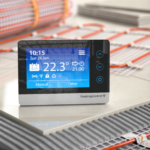Thin flowing screeds are a levelling layer applied to the top of a concrete subfloor, typically ranging from 8mm to 40mm in thickness. This thin layer helps to create a smooth, level surface for the final floor finish, such as tiles or laminate flooring. Typically made from cementitious materials, sand, and additives, thin screeds are mixed with water and applied using specialised equipment to ensure an even distribution across the subfloor.
Thin screeds are ideal for incorporating low profile wet and electric underfloor heating systems, providing an efficient and effective solution for comfortable indoor environments. Their excellent thermal responsiveness and distribution allows for rapid temperature changes in the floor surface, leading to a more tailored and efficient heating experience.
With lightweight yet durable properties enabling fast, adaptable installation, thin screed is a popular choice for modern construction and renovation projects.
Why use thin screed?
Thin screeds are worth installing because of a number of key advantages:
- Low thermal resistance – Thin screed promotes efficient heat distribution throughout a building, leading to lower energy consumption, reduced heating costs and lower environmental impact. It has quicker heat-up times and cool-down times, which can reduce energy consumption compared to thicker traditional screeds
- Easy and rapid installation – The low weight of thin screeds and minimal thickness makes it simple to install. Reducing the overall weight of the building can be particularly beneficial in high-rise developments, where every pound saved on the flooring can translate into substantial cost savings over the structure’s lifetime
- Adaptable – Thin screeds are ideal for renovating existing buildings without significantly raising floor levels or compromising headroom. This adaptability has contributed to the increasing popularity of thin screed flooring solutions in urban areas, experiencing a surge in redevelopment and regeneration projects
- Sustainable – By using less materials and optimising thermal performance, thin screeds are environmentally friendly
- Durable – With advancements in materials and technology, thin screed systems now offer improved durability and resistance to wear, making them suitable for both residential and commercial applications
How do I install it?
There are a few key factors to consider when installing thin screeds:
- Properly prepare the substrate with thorough cleaning and levelling to ensure a smooth, even surface for the application of the thin screed
- Select high-quality cementitious or calcium sulphate thin screed mix based on the specific requirements of the project, considering factors such as thickness of screed, heat output required and timeframe
- Use accredited installers to ensure a correct install and finish
How do I maintain thin screed?
Thanks to improved durability and resistance, thin screeds are installed to last. Once installed, cured and covered by the final floor finish thin screeds need nothing else. If you get them wet, dry them back out. If you replace the floor finish, just repair and clean the surface of the screed before applying the new finish.





